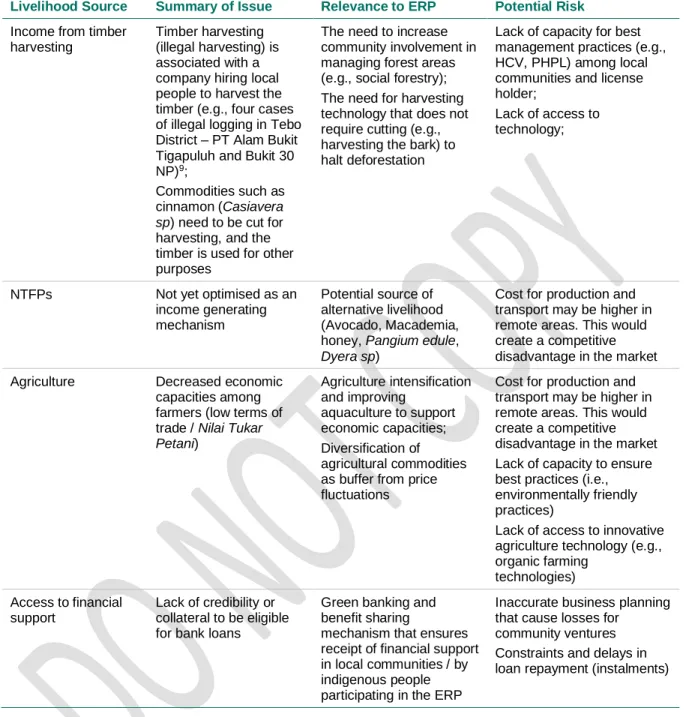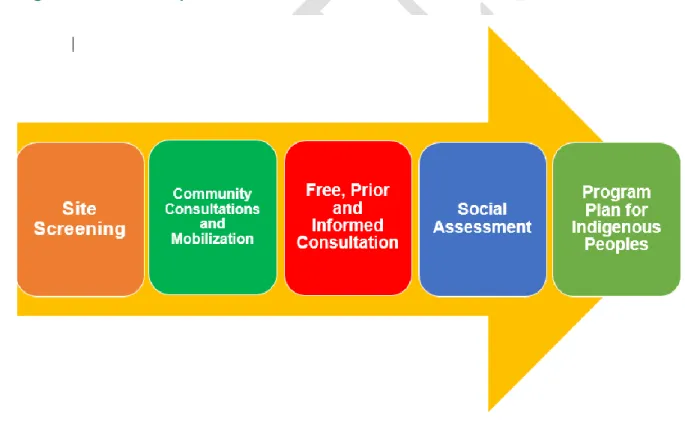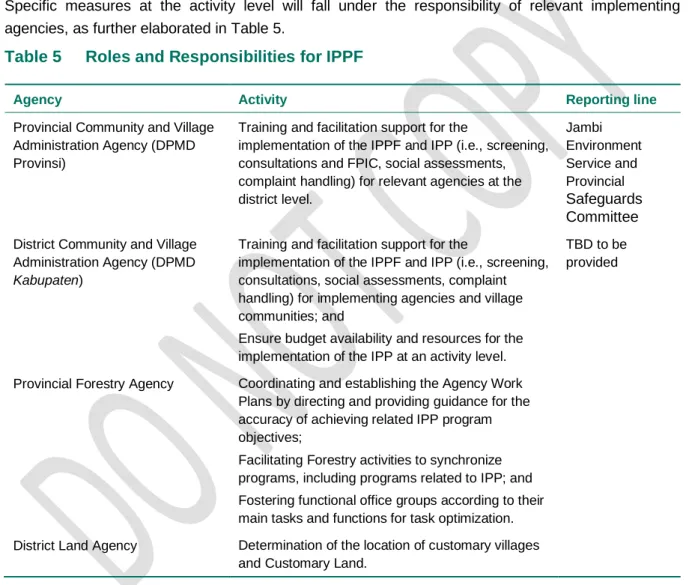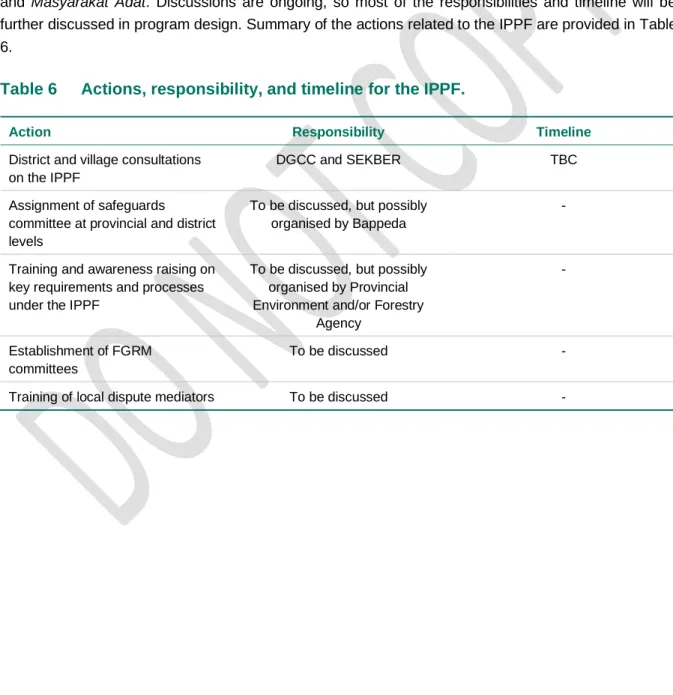INTRODUCTION
PROJECT DESCRIPTION
PURPOSE OF THE FRAMEWORK
SCOPE OF THE APPLICATION
RELEVANT LEGAL FRAMEWORK AND REGULATIONS
INDONESIAN REGULATIONS
This section provides an overview of the risks and potential impacts on indigenous peoples resulting from the implementation of the J-SLMP. BRWA is a forum established by several NGOs in Indonesia, such as the Alliance of Indigenous Peoples of the Archipelago (Aliansi Masyarakat Adat Nusantara/AMAN), the Participatory Mapping Network (Jaringan Kerja Pemetan Partisipatif/JKPP), Forest Watch Indonesia (FWI), the Consortium for Support Community Forestry System (Konsorsium Pendukung Sistem Hutan Kerakyatan /KpSHK) and Sawit Watch (SW). In the event that such on-site verification is required, an initial notice will be communicated to the representatives of the indigenous peoples and Masyarakat Adat concerned, outlining the purpose and approach of the review process.
Indigenous peoples' views must be taken into account during the implementation of the J-SLMP while respecting their current practices, beliefs and cultural preferences. The results of the consultations will be documented in the periodic reports and submitted to MoEF and the World Bank for review. The Environmental and Social Safeguards, which will be attached to the Provincial Safeguards Committee, will provide technical, advisory and supervisory support to the implementation of the IPPF.
Ensuring the availability of budget and resources for the implementation of PPI at the activity level. The overall progress and implementation of the IPPF/IPP will also be documented in the annual progress report on the implementation of the J-SLMP. Assesses, based on meaningful consultation with affected IP communities, the potential negative and positive effects of the project.
This section describes the mechanisms and benchmarks appropriate for the project to monitor and evaluate the implementation of the IPP.

ASSESSMENT AGAINTS THE WORLD BANK OPERATIONAL POLICIES ON
SUMMARY OF POTENTIAL RISKS AND IMPACTS
Additional activity-level screening using the above criteria by the respective implementing agencies will be required as part of the IPPF during the J-SLMP implementation phase. Each step of the screening process will be duly documented, including key concerns and risks observed during the ground truth/field verification. The process above is an integral part of the J-SLMP implementation and therefore continues after its completion.
Opportunities to increase community participation and the benefits of the J-SLMP; And. The justification for the benefit-sharing mechanism for indigenous peoples will be strengthened through formal recognition of the customary group by the Government of Indonesia. Overall coordination and technical oversight of the IPPF will remain the responsibility of the Provincial Security Council Committee, in conjunction with MOEF.
The outcome of the M&V will be documented in the J-SLMP progress report, which will outline key recommendations and specific time-bound action items to strengthen IPPF implementation. As part of the project's technical support, the World Bank will also periodically oversee the implementation of the IPPF and IPP at the program level. In the context of the IPPF, relevant measures will be included under the FGRM to ensure that affected indigenous peoples and local communities are aware of their rights and to ensure that the system established under the Program is accessible and free of charge.
Discussions are ongoing, so most responsibilities and timelines will be discussed further in the program design.
INDIGENOUS PEOPLES IN JAMBI AND RELEVANT ISSUES FOR J-
CAPACITY ASSESSMENT FOR MANAGEMENT OF RISKS AND
A group of people who share the same lineage originating from the indigenous people of the area;. The results of the review will inform potential risks before they are asked to participate in the activities. Based on the outcome of the social assessment, further measures are taken to ensure all the benefits and mitigate the anticipated negative impacts.
The implementing district agencies, under the coordination and guidance of the District-level Safeguards Committee, will report on IPPF/IPP implementation to the Provincial Safeguards Committee, which will be responsible for reviewing, monitoring specific measures and submitting final progress reports to the Ministry of Finance and the World Bank. The Jambi Provincial Government, in coordination with the Safeguards Committee, will ensure regular monitoring and evaluation (M&E) of the implementation of the IPPF/IPP and the progress of the planned activities. It includes a gender-sensitive assessment of the perception of affected IPs about the project and its impact on their social, economic and cultural status.
This section describes the responsibilities of the institutional arrangement and the mechanisms for implementing the various measures of the IPP. It also describes the process of involving relevant local organizations and/or NGOs in implementing the measures of the IPP.

IMPLEMENTATION ARRANGMENTS
IDENTIFICATION CRITERIA
The terms "indigenous peoples", "indigenous ethnic minorities" and "tribal groups" describe social groups with a social and cultural identity that differs from the dominant society, making them vulnerable to being disadvantaged in the development process. Common attachment12 to geographically separated ancestral habitats or territories in the project area and to natural resources in these habitats and territories;. Conventional cultural, economic, social or political institutions that are separate from those of the dominant society and culture; and.
A group that has lost its common attachment to geographically separate habitats or ancestral territories in the J-SLMP and future ERP area due to involuntary termination13 remains eligible for coverage under the policy. 13 Forced disruption' refers to the loss of collective attachment to geographically separated habitats or ancestral territories that occurs during the lifetime of the group members concerned as a result of conflict, government resettlement programs, dispossession of their land, natural disasters, or the incorporation of such territories into urban areas. The maps will be used to identify the existence of indigenous communities in the project area.
PHASED IMPLEMENTATION OF THE IPPF
- Site Screening
- Community Consultations and Mobilization
- Securing Free, Prior and Informed Consultation
- Social Assessment
- Program Plan for Indegenous Peoples
During the implementation of the J-SLMP, an updated social assessment must also be carried out to monitor the positive and negative impacts of the project and get feedback from the project-affected people. Both qualitative and quantitative data will inform the assessment, including baseline information on the demographic, social, cultural and political characteristics of the affected indigenous peoples or Masyarakat Adat, the land and territories they have traditionally owned or customarily used or occupied, and natural resources; on which they depend. For activities where the social assessment indicates that indigenous peoples and Masyarakat Adat are the only or the overwhelming majority of direct beneficiaries, a separate IPP is not required and the elements of an IPP should be integrated as part of the design of the J- SLMP activities.
The role of field officials in the form of community aid and assistance is a form of the role of mediators, educators or experts. In addition to the IPPF/IPP implementation, the M&E arrangements will also be necessary to monitor the implementation of the BSP and how the benefits are distributed among affected communities. To ensure accessibility, consultations and disclosure of the IPPF and IPP will take place at the locations of the program activities where there are indigenous peoples and Masyarakat Adat: Further consultations and disclosure of the IPP will be provided at locations accessible to indigenous people peoples and Masyarakat Adat such as Village/Village Houses, Village/Village Offices, District DPMPD Offices and Provincial DPMPD Offices.
This section provides a general description of the project; discusses project components and activities that may have IP impacts; and identify the project area. In the case of project activities that require broad community support, documents the process and outcome of consultations with affected IP communities and any agreements resulting from such consultations on project activities and safeguards that address the impacts of those activities ;. iv) Describes the consultation and participation mechanisms that will be used during implementation to ensure the participation of IPs during implementation; and. v) Confirm draft and final disclosure to affected IP communities.

BENEFIT SHARING ARRANGEMENT FOR INDIGENOUS PEOPLES AND
INSTITUTIONAL ARRANGEMENT
Specific measures at the activity level will fall under the responsibility of relevant implementing agencies, as further elaborated in Table 5. Provincial Forestry Agency Coordination and establishment of the Agency's work plans by directing and providing guidance for the accuracy of the achievement of related IPP- program objectives;. It will include key recommendations and proposed measures to address specific risks emerging as a result of implementing J-SLMP activities.
MONITORING AND EVALUATION
DISCLOSURE OF THE INDIGENOUS PEOPLES PLAN
The IPPF and IPP will also be published on the Jambi Provincial Government website (http://jambiprov.go.id). The program-level IPP will similarly be disclosed on the World Bank and Ministry of Finance websites prior to public consultations, and the final version will be disclosed prior to the commencement of any activities that may affect Indigenous Peoples and Masyarakat Adat.
REPORTING
FEEDBACK AND GRIEVANCE REDRESS MECHANISM (FGRM)
Farid - BKSDA Jambi Cagar Alam (mangroves) berada di pantai Tanjung Jabung Timur and Tanjung Jabung Barat. Provides background information on the demographic, social, cultural and political characteristics of affected IP communities; land and territories traditionally owned or customarily used or occupied; and the natural resources on which they depend. Critical to determining potential adverse impacts is an analysis of relative vulnerability and risks for affected IP communities in light of their specific circumstances and close ties to land and natural resources and lack of gender-responsive access to opportunities. relative to those available to other social groups in the communities, regions or national societies in which they live.
Identifies and recommends, based on meaningful consultation with affected IP communities, measures necessary to avoid adverse effects or, if such measures are not possible, identifies measures to minimize, mitigate and/or compensate for these effects and to ensure that IPs receive the appropriate cultural benefits within the project. Disclosure, Consultation and Participation This section. i) Describes the process of information disclosure, consultation and participation with IP affected communities that can be carried out during project preparation; ii) Summarize their comments on the results of the social impact assessment and identify the concerns raised during the consultation and how they have been addressed in the design of the project; iii). This section specifies measures to avoid adverse impacts on IP; and where avoidance is impossible, specifies measures to minimize, mitigate and compensate the identified unavoidable negative impacts for each group of IPs affected.
This section includes measures to strengthen the social, legal and technical capacities of (a) government institutions to address IPs issues in the project area; and (b) IPs organizations in the project area to enable them to represent the affected IPs more effectively. It also specifies arrangements for the participation of affected IPs in the preparation and validation of monitoring and evaluation reports.
